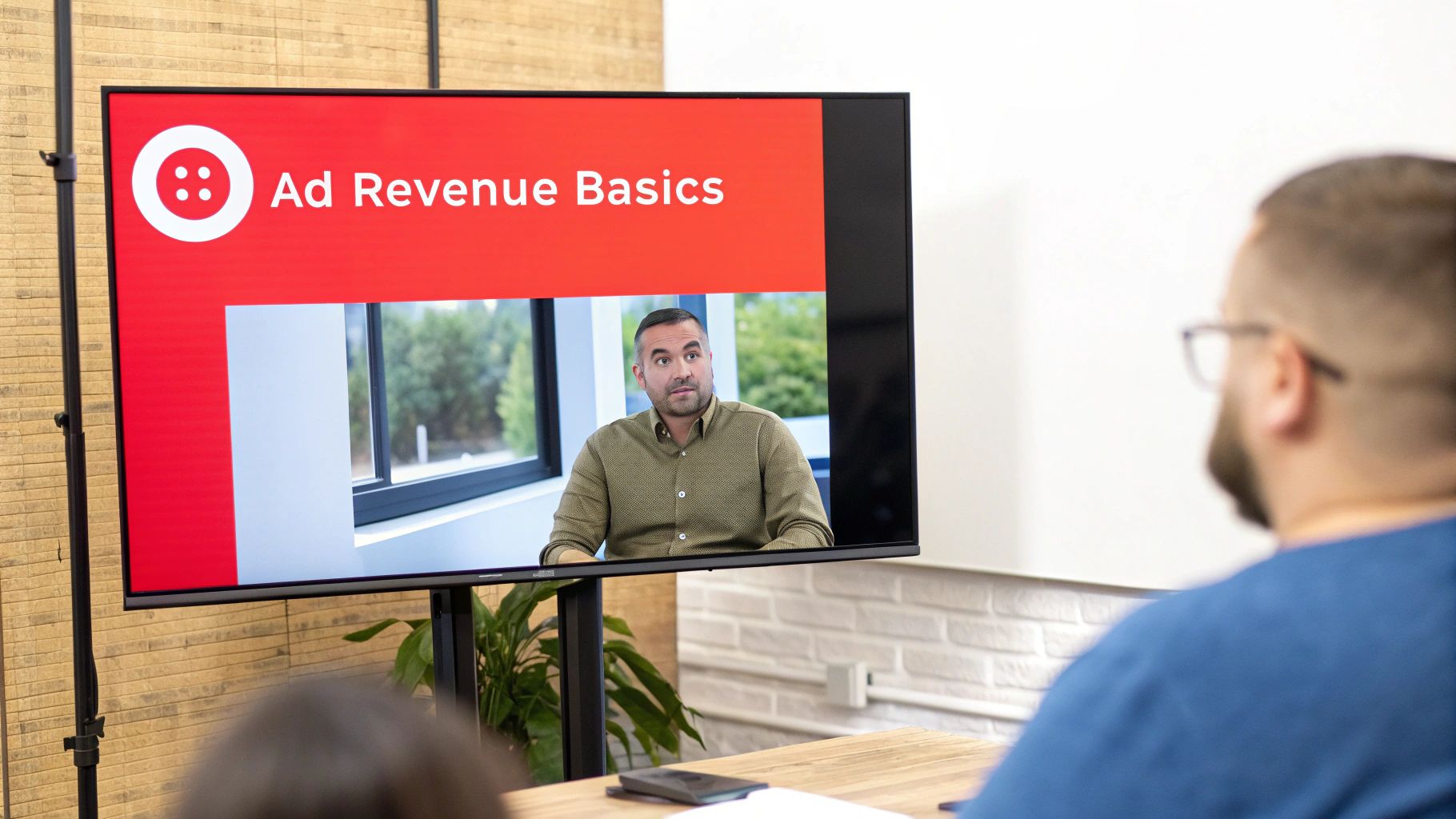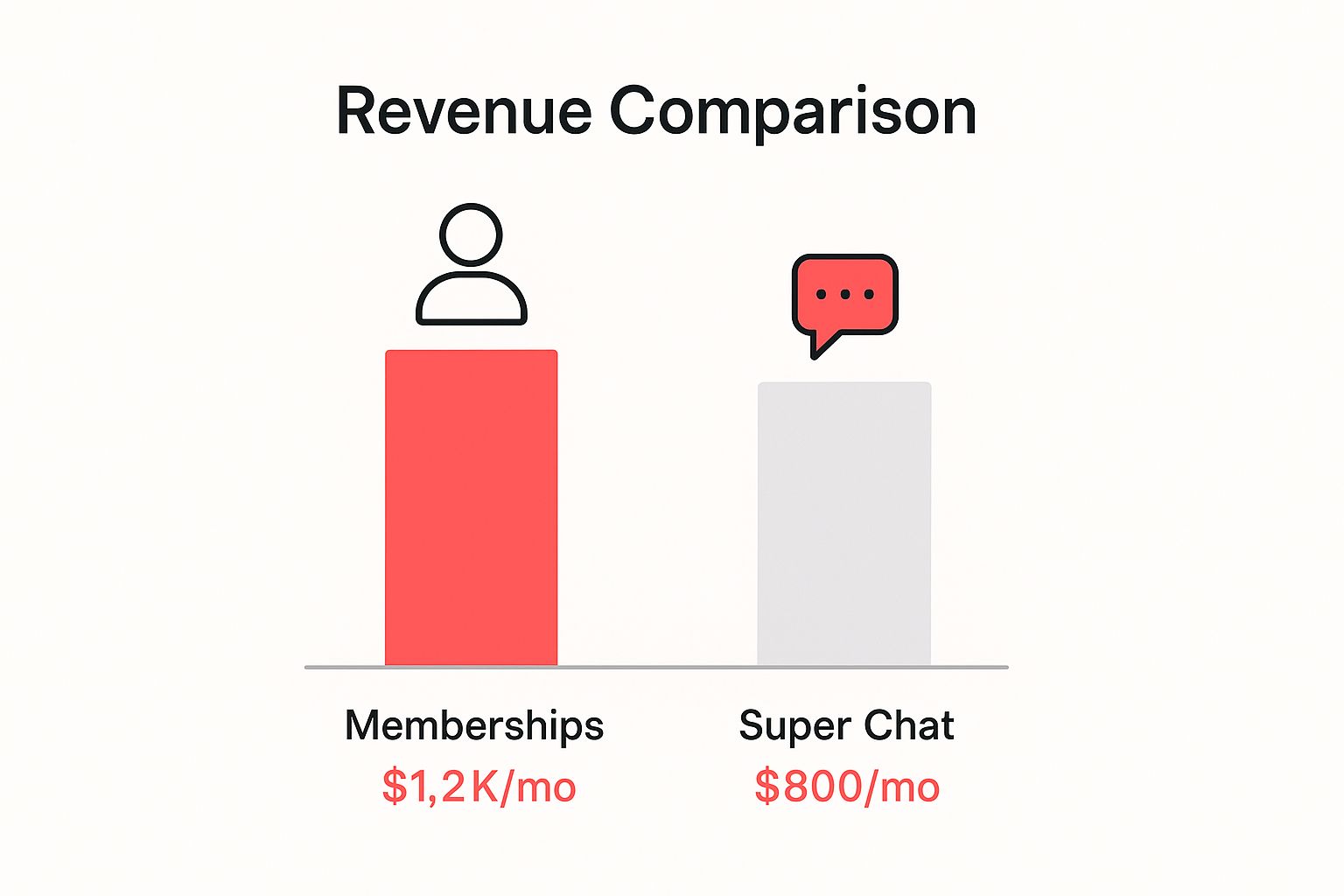The Creator Economy: What Is Monetizing YouTube?
Monetizing YouTube means turning your video content into a source of income. It's the process of enabling creators to earn revenue, primarily through advertising, channel memberships, and merchandise sales. This shift from hobby to potential career has empowered countless individuals to build businesses around their passions. This is largely thanks to the platform's evolution after Google acquired it in 2006. This acquisition helped propel YouTube to become a dominant force, evolving from a simple video-sharing platform to a global income generator.

Monetizing YouTube involves enabling creators to earn revenue from their content, primarily through ads, memberships, and merchandise. Since its acquisition by Google in 2006, YouTube has evolved into the world's largest video platform. It boasts over 2.5 billion monthly active users and hosts more than 3.9 billion videos as of early 2025. YouTube's monetization program, the YouTube Partner Program (YPP), allows eligible creators to earn money from ads shown on their videos.
Find more detailed YouTube statistics
Understanding the YouTube Partner Program (YPP)
The YouTube Partner Program (YPP) is the cornerstone of YouTube monetization. It's the gateway to unlocking various income streams on the platform. This program allows creators to access features like displaying ads on their videos, offering channel memberships, and enabling Super Chat during live streams. For example, a creator in the YPP can earn money every time an ad plays before their video or when a viewer becomes a paying member for exclusive content. However, access to the YPP isn't automatic.
Meeting the Eligibility Criteria
There are specific requirements creators must meet before applying to the YPP. These include reaching minimum thresholds for subscribers and watch hours. These thresholds, 1,000 subscribers and 4,000 watch hours over the past 12 months, demonstrate a creator's ability to consistently engage an audience. This ensures a baseline level of viewership for potential advertisers. Additionally, creators must adhere to YouTube's community guidelines and copyright policies. This means content must be original, or used with proper permissions, and free of any violations. Reaching these milestones is often the first hurdle for aspiring YouTube entrepreneurs.
Beyond the Basics: Expanding Your Monetization Strategy
While the YPP is a significant starting point, successful YouTubers often diversify their income streams beyond ad revenue. This involves exploring opportunities like brand partnerships, affiliate marketing, and merchandise sales. For example, a creator might partner with a company to promote products, or earn a commission through affiliate programs. This multifaceted approach not only increases earning potential but also creates a more stable income flow, less reliant on ad revenue fluctuations. Diversifying income streams is a key strategy for long-term success.
Cracking The Code: YouTube Partner Program Essentials

Want to make money on YouTube? The YouTube Partner Program (YPP) is the key. This program unlocks several ways to earn, like ad revenue, channel memberships, and fan funding. But joining isn't as simple as just posting videos. You need to understand the YPP essentials.
Meeting the Thresholds: Subscribers and Watch Hours
Before applying to the YPP, you have to meet specific requirements. First, you need 1,000 subscribers. This shows YouTube that your content is engaging and keeps viewers coming back. You also need 4,000 valid public watch hours in the last 12 months. This significant watch time ensures a solid viewer base for potential advertisers. These milestones might seem challenging, but with consistent uploads and a smart content strategy, they're achievable. You can learn more about growing your channel at this helpful resource: How to master....
Adhering to Content Policies: Staying Compliant
Subscriber and watch hour counts aren't the whole story. Sticking to YouTube's content policies is just as important. Your content must follow community guidelines and copyright rules. Using copyrighted material without permission, creating misleading content, or engaging in harmful practices can disqualify you from the YPP. Understanding and following these policies is essential.
Content Considerations: Quality Over Quantity
Hitting the subscriber and watch hour numbers is a must, but the quality of your content matters just as much. Even if you reach those thresholds, some content types are harder to monetize. Reusing content from other sources without adding your own commentary or transforming it significantly makes monetization less likely. Simply compiling clips from other videos won't work. Focus on original, high-quality content that offers something unique to your viewers.
The following table summarizes the key requirements for joining the YouTube Partner Program. It provides a quick overview of the thresholds you need to meet and the policies you need to follow.
YouTube Partner Program (YPP) Eligibility Requirements A comprehensive breakdown of the current eligibility requirements for joining the YouTube Partner Program and beginning monetization
| Requirement | Threshold | Notes |
|---|---|---|
| Subscribers | 1,000 | Demonstrates audience engagement and retention |
| Valid Public Watch Hours | 4,000 (in the last 12 months) | Ensures substantial viewership for potential advertisers |
| Content Policies | Full compliance | Adherence to community guidelines and copyright rules is mandatory |
As the table highlights, meeting the YPP requirements involves more than just numbers. Creating quality, original content and following YouTube's policies are critical for success.
Positioning Your Channel for Success: First-Time Approval
Applying to the YPP can feel complicated. But if you understand the basics—hitting the thresholds, following content policies, and prioritizing quality content—you'll greatly improve your chances of getting approved on your first try. This proactive approach will save you time and headaches. By strategically positioning your channel, you can apply with confidence. This means knowing your niche, understanding your target audience, and having a content strategy that aligns with YouTube's monetization guidelines.
Revenue Streams That Actually Work For Creators
Monetizing YouTube isn't just about joining the YouTube Partner Program (YPP). It's about finding the right revenue streams for your content and audience. While the YPP lets you earn ad revenue, smart creators use a mix of methods to earn more.
Ad Revenue: Understanding the Different Formats
Joining the YPP unlocks various ad formats. These include display ads shown beside your video and skippable video ads played before your content. But not all ad formats are created equal. Skippable video ads, for instance, can earn more due to their targeted approach, even if they can be annoying for viewers. Figuring out which formats work best for your audience and bring in the most revenue is key. This means analyzing your channel's analytics and testing different ad placements.
Channel Memberships: Building a Loyal Community
Beyond ads, channel memberships help build a dedicated fan base and earn recurring revenue. Offering exclusive perks like badges, emojis, and members-only content creates a sense of community and offers value for a monthly subscription. Your audience becomes actively invested in your channel's growth, not just passively watching. Building a successful membership program means creating real engagement and consistently providing value that keeps subscribers happy. The infographic below compares average monthly revenue from memberships and Super Chat:

This visualization shows that memberships can generate significantly more recurring revenue than one-time Super Chat donations. It highlights the importance of building a loyal subscriber base.
Super Chat and Super Stickers: Engaging Your Audience During Live Streams
Super Chat and Super Stickers are another way to earn money, especially for channels with regular live streams. These let viewers pay to highlight their messages in chat, increasing visibility and interaction. This is especially helpful for creators who have strong audience engagement during streams. Relying only on Super Chat and Super Stickers can be risky though, as earnings depend on viewer generosity and how often you stream.
Merchandise Shelf: Integrating Products Seamlessly
Selling merchandise directly through your videos using the merchandise shelf is another strong strategy. Viewers can buy branded products right below your videos. This lets fans support you directly, strengthening the creator-audience connection. Merchandise can become a major revenue source for channels with a strong brand.
Beyond YouTube: Diversifying Your Income
Many successful YouTubers look beyond YouTube's built-in monetization tools for other income sources. These include brand partnerships, affiliate marketing, and selling online courses or digital products. Diversifying your income is crucial for building a sustainable online business that isn't totally reliant on YouTube's advertising system. Ad revenue reached $36.1 billion in 2024, a 14.6% increase from the previous year. YouTube ads and subscription revenue even topped $50 billion over the last four quarters of 2024. Learn more about these statistics. Additional strategies can be found here.
Utilizing Helpful Resources
To check if your channel is eligible for monetization, use a YouTube Monetization Checker. Understanding the requirements is the first step to maximizing your earning potential. Remember, successful YouTube monetization needs a strategic approach. By understanding your audience, experimenting with different revenue streams, and diversifying your income, you can build a thriving online business around your content creation passion.
Here's a table summarizing different YouTube monetization methods:
YouTube Monetization Methods Comparison
This table compares different ways YouTube creators can earn money, including typical earnings and requirements.
| Monetization Method | Eligibility Requirements | Earning Potential | Best For |
|---|---|---|---|
| Ad Revenue | YPP membership (1,000 subscribers, 4,000 valid watch hours) | Varies based on views, ad engagement, and audience demographics | Creators with a large and engaged audience |
| Channel Memberships | YPP membership, 1,000 subscribers | Recurring monthly revenue from subscriber fees | Creators with a loyal and dedicated fan base |
| Super Chat & Super Stickers | YPP membership, enabled for live chat | Varies greatly based on viewer generosity during live streams | Creators who actively engage with their audience during live streams |
| Merchandise Shelf | YPP membership, eligible merchandise | Varies based on product pricing and sales volume | Creators with established branding and a loyal audience |
| Brand Partnerships & Affiliate Marketing | No specific YouTube requirements | Varies greatly based on deal terms and product/service promotion | Creators with a strong and relevant audience for potential partners |
Key takeaways from this table: consistent income can be achieved through memberships, while Super Chat and merchandise rely on audience interaction and brand loyalty. Diversifying beyond YouTube offers more revenue potential.
Decoding Your Analytics: The Metrics That Matter
Understanding your YouTube analytics can feel overwhelming. There are so many statistics, it's easy to get lost. But, if you concentrate on the metrics that directly impact your earnings, you can guide your channel towards greater success with monetization.
Watch Time and Its Impact on Ad Revenue
Watch time isn't just about how many people view your videos; it's about how long they watch. It's a critical indicator of audience engagement and a major factor in successful YouTube monetization. Longer watch times often mean more ad impressions, which boosts your revenue.
For example, a 10-minute video with a 50% average view duration will generate more ad revenue than a 5-minute video with the same view count but a lower watch time. This happens because longer videos allow for more strategically placed ad breaks. Understanding this relationship is key to maximizing your earnings.
CPM, RPM, and Geographic Influence
Two essential metrics for understanding your YouTube earnings are CPM (Cost Per Mille) and RPM (Revenue Per Mille). CPM represents what advertisers pay for 1,000 ad views. RPM shows what you earn per 1,000 views after YouTube takes its share. These rates can actually change based on where your viewers live.
Higher CPMs are common in regions with stronger economies, directly impacting your total revenue. In 2025, the platform's average CPM was around 2.50 EUR, but this can range from 1.00 EUR to 8.00 EUR based on video content and audience location. This variation really affects creators' earnings, emphasizing how important niche targeting and audience location are for your monetization strategy. This shows how YouTube’s monetization system is dynamic and complex, constantly changing as the platform grows internationally. For a deeper dive into the numbers, check out: YouTube User Statistics.
Audience Demographics and Their Effect on Earnings
Who makes up your audience can really influence your CPM rates and overall revenue. For instance, a channel targeting a niche audience with high purchasing power is likely to attract premium advertisers and higher CPMs. On the other hand, a channel with a broad, less-targeted audience may see lower CPMs. Knowing your audience and tailoring your content to attract valuable demographics makes a real difference. You might also find this helpful: How to Master....
Optimizing for Higher Earnings: Practical Strategies
By focusing on the right metrics, you can make smart content decisions that increase your earnings. Create engaging content to encourage longer watch times. Understand your audience demographics to attract high-paying advertisers. And try different ad formats to optimize your RPM. Also, keep in mind how your content fits with advertiser-friendly guidelines to maximize your earning potential. Combining this strategic approach with a solid understanding of your analytics is the foundation of a successful YouTube monetization strategy.
Beyond The Algorithm: Alternative Revenue Pathways
Smart creators know that relying only on YouTube's built-in monetization isn't always a reliable strategy. For sustainable income, you need to look beyond the algorithm. Diversifying your revenue streams protects you from algorithm changes and fluctuating ad rates. This section explores how successful creators build robust income sources.
Brand Partnerships: Aligning With Your Values
Brand partnerships are a powerful monetization method. This means collaborating with companies to promote their products or services to your audience. The key is choosing partners that align with your content and resonate with your viewers. For example, a gaming channel partnering with a gaming hardware company is a natural fit. This builds trust and authenticity, making campaigns more effective. Accepting every offer can damage your credibility, so choose wisely.
Affiliate Marketing: Earning Passively
Affiliate marketing lets you earn even when you're not creating new content. You promote other companies' products or services and earn a commission on sales made through your unique affiliate links. Don't be overly promotional, though. Integrate affiliate links naturally within valuable content, offering helpful recommendations rather than pushing sales.
Products and Services: Expanding Your Brand
Many YouTubers sell their own products or services. This could be anything from merchandise and online courses to consulting and premium subscriptions. This often surpasses ad revenue alone. Think about the unique value you can offer beyond your standard videos. Perhaps you could create educational resources, offer personalized coaching, or design exclusive merchandise reflecting your channel’s brand.
Understanding your content's return on investment is essential. Check out this article to boost your Content Marketing ROI.
Building Financial Resilience
Diversifying your revenue isn't just about maximizing income. It's about building financial resilience. By not relying on a single source, you protect yourself from online uncertainties. Monetizing YouTube channels can be very lucrative. Top creators earn tens of millions annually from combined ad revenue, sponsorships, merchandise sales, and other avenues. In 2024, YouTube ad revenue hit $36.1 billion, a 14.6% increase from 2023. This growth is fueled by YouTube's expanding user base, with over 2.74 billion monthly users. Explore this topic further.
Realistic Timelines and Potential Returns
Building a successful merchandise line or online course takes time and effort. Brand partnerships and affiliate marketing also require planning and outreach. The potential rewards are high, but it’s important to set realistic expectations and appreciate incremental progress. A smaller channel might focus on building a strong affiliate marketing strategy first, before developing a complex product line. This phased approach allows for sustainable growth and a manageable workload.
By understanding and using these strategies, you can create a more sustainable and fulfilling YouTube career. This not only boosts your income potential, but also lets you focus on creating great content.
Crafting Content That Maximizes Earnings

Successfully making money on YouTube involves more than just turning on ads. It's about creating videos that engage viewers and naturally lead to monetization opportunities.
Structuring Videos for Optimal Ad Breaks and Retention
Think of your video structure as a story. Strategic ad placement is key. Inserting ads at natural breaks, like between segments, creates a smooth viewing experience. This maximizes ad revenue without being disruptive. Similarly, compelling hooks and consistent engagement improve audience retention, leading to longer watch times and more ad opportunities.
Creating Binge-Worthy Content Series
Building a library of interconnected content is a powerful strategy. Creating video series around a specific theme encourages viewers to watch multiple videos in a row. This increases watch time and ad impressions. This approach builds loyalty and establishes you as an expert in your niche. For example, a cooking channel might create a series on Italian cuisine, with each video covering a different dish. This binge-worthy approach boosts revenue over time.
Appealing to Premium Advertisers While Staying Authentic
The advertisers your content attracts impact your CPM (Cost Per Mille), or the revenue you earn per 1,000 views. Content that appeals to premium advertisers usually generates higher revenue. This doesn't mean changing your style. Understanding your audience's demographics and interests helps you tailor content to attract advertisers willing to pay more. Content focused on personal finance or technology often attracts premium advertisers due to the high purchasing power of those viewers.
Leveraging Seasonal Trends and Evergreen Content
Planning content around seasonal trends is essential. Advertising rates tend to be higher during holidays. Balancing this with evergreen content—content that stays relevant year-round—ensures a consistent income stream. This blend creates a sustainable revenue model, rather than relying on viral moments.
YouTube’s monetization features are always evolving. For instance, Shorts now make up roughly 20% of total video content, attracting new viewers and revenue. Over 100 million YouTube Premium and Music subscriptions globally offer another income source through revenue sharing. Find more detailed statistics here.
Building a Sustainable Revenue Engine
Monetizing YouTube is about building a sustainable revenue engine aligned with your creative goals. It's about creating content that satisfies your audience and maximizes your earnings. By understanding these strategies, you can build a successful channel.
Ready to grow your YouTube channel and reach its full potential? MonetizedProfiles offers monetization-approved YouTube accounts, giving you a head start. Skip the initial setup and start earning ad revenue immediately. Visit MonetizedProfiles today to learn more.








